I'm clak clak clakin at yo door.
Last active 3 hours ago
Don't wanna be here? Send us removal request.
Text

A silhouette of a Vultures dorsal side. What odd creatures.
5 notes
·
View notes
Text
Little fan made trailer of the upcoming DLC of Rain World: The Watcher by Videocult I hope you may like and feel the love put into it as much as I did!🦉❤️ Background/animation done by me and VFX by the amazing zaadworks on twitter!
2K notes
·
View notes
Note
You've done excellent analyses of the mechanics of the Farm Arrays crop harvesters and the iterator labs, and I've wanted to ask. How do you think the void fluid drill silos functioned? Because I have no clue what all these bits&bobs could be for.



Here's the filtration system drill for reference (in an easier to see palette)

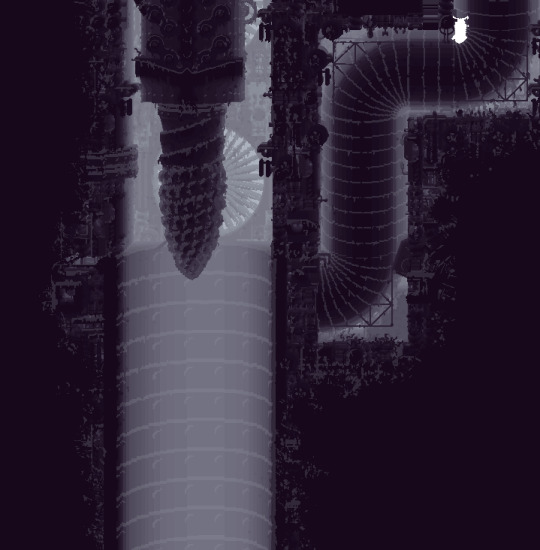
Here's also the region art for reference

I think this part is the engine, the part that powers up the drill's spin

And it could also be an automatic assembly point, more on that in a moment
Now, the screw-like shaft, which I thought was a different kind of drill at some point, could have that shape in order to transmit momentum

Now, as for where is all that shaft retracted to, it could be a telescopic mechanism
Or it could be soft when stored in the pipe behind the engine then harden in exposure to air, like noodlefly stingers

Or it could be assembled from base materials on the engine itself, meaning the engine could be a purposed organism creating the shaft like snail creates its shell (but likely faster)
Iterators likely do this at a large scale in the memory conflux assembly, and their components were likely made this way
... although, this assembly theory would only explain the great length and segmented look, and would not be particularly compatible with retracted drills like the one in filtration system, which would still require something like the first two theories. Maybe a combination of these is what's happening
The corncob-like looking tip is definitely the actual drill
Now, I don't know why this one has two engines

Maybe it split in half, maybe an extra one was added because it needed an extra boost (even though this one is shallower than the others)
Maybe the engine or part of it also goes down to install the walls of the holes as it goes deeper
Void fluid seems to have been collected through these holes into the corresponding pipes to be filtered and moved around, rather than absorbed directly through the drill
If I knew how exactly drilling for oil works I'd probably be able to say more here
Maybe I'll add more in a reblog after I inform myself with that
46 notes
·
View notes
Note
What do you think is the lore reason for creature pipes existing?

Obviously, they exist in-game pretty much solely for the gameplay reason of traveling between rooms, and the way they work is also only really for gameplay purposes. But like, outside of that, what were they actually used for? What are they? Why do they function the way they do? Hell, why were they even built? They still must exist in Rain Worlds infrastructure for a reason.
Creature's that enter them can't stop moving forward until they're out the other side. Creatures also can't do anything while traveling in the pipes, as evidenced by predators not being able to grab prey while traveling in it. Are creatures restrained while in the pipe? The pipes symbol is distinct, almost as if to invite sight-based creatures to enter them. Their symbols light up with the corresponding color's of creatures approaching them, meaning they can sense things. They seem at least somewhat technologically advanced due to this. Are they alive like other machinery? Perhaps the insides of the pipe are biological and soft, able to contract and hold a creature in place as it's moved . . . . . Kinda like a sphincter . . . . Now that I think about it.
All of this has led me to think that creature pipes are basically the rain world equivalent of the "salmon cannon." A way for designated purposed organisms to harmlessly move about the surface world, to complete whatever task they're made for. Now only used by the countless forms of feralized surface fauna.

But anyway, any thoughts from you on what creature pipes are?
It might disappoint you to say this but I think that its just purely a gameplay feature meant to indicate some kind of "crack" in the wall you go through, at least for dens and room entrances
I feel like shortcuts have more going on, but theres also no reason why the ancients would ever lay out anything like this and want to crawl into shitty little pipes about it
I'm pretty sure creatures not being able to see you in the pipes is a bug that ended up becoming a feature
Maybe the pipes are purposed organisms. Idk. They're way too gameplay focused and feel too disconnected from lore to be much else but that. But I also think the pipes within Industrial Complrx are alive because they look like intestines
The symbols are different so that tje player can recognize where they are and where it'll takr them, similar to how objects flash when you walk next to them
#rw design#game mechanics#rw architecture#rw lore#eh fair enough#I just think these sorts of things are fun to think about#I love finding justification for things existing the way they do in game#even if their really just arbitrary
49 notes
·
View notes
Note
Oh, I never meant to imply that benefactors would use pipes at all. They clearly have their own more refined passages that we just can't see. I was more just saying that if they are, in fact, made for a purpose, that I think that purpose would be solely for smaller purposed organisms designed to like repair infrastructure on the surface or whatever.
This also kinda ties into the shelters as well. Because as of the downpour lore pearls, we now know that there was some infrastructure created for the accommodation of purposed organisms in the form of the shelters.

Having designated paths like the creature pipes that are designed to funnel smaller purposed organisms into desired locations so they can complete their specific task would likely be of at least some priority to the benefactors. After all, you'd want at least some organization and ease of access for Purposed Organisms so that they can function and do what you made them to do more efficiently, right?
What do you think is the lore reason for creature pipes existing?

Obviously, they exist in-game pretty much solely for the gameplay reason of traveling between rooms, and the way they work is also only really for gameplay purposes. But like, outside of that, what were they actually used for? What are they? Why do they function the way they do? Hell, why were they even built? They still must exist in Rain Worlds infrastructure for a reason.
Creature's that enter them can't stop moving forward until they're out the other side. Creatures also can't do anything while traveling in the pipes, as evidenced by predators not being able to grab prey while traveling in it. Are creatures restrained while in the pipe? The pipes symbol is distinct, almost as if to invite sight-based creatures to enter them. Their symbols light up with the corresponding color's of creatures approaching them, meaning they can sense things. They seem at least somewhat technologically advanced due to this. Are they alive like other machinery? Perhaps the insides of the pipe are biological and soft, able to contract and hold a creature in place as it's moved . . . . . Kinda like a sphincter . . . . Now that I think about it.
All of this has led me to think that creature pipes are basically the rain world equivalent of the "salmon cannon." A way for designated purposed organisms to harmlessly move about the surface world, to complete whatever task they're made for. Now only used by the countless forms of feralized surface fauna.

But anyway, any thoughts from you on what creature pipes are?
It might disappoint you to say this but I think that its just purely a gameplay feature meant to indicate some kind of "crack" in the wall you go through, at least for dens and room entrances
I feel like shortcuts have more going on, but theres also no reason why the ancients would ever lay out anything like this and want to crawl into shitty little pipes about it
I'm pretty sure creatures not being able to see you in the pipes is a bug that ended up becoming a feature
Maybe the pipes are purposed organisms. Idk. They're way too gameplay focused and feel too disconnected from lore to be much else but that. But I also think the pipes within Industrial Complrx are alive because they look like intestines
The symbols are different so that tje player can recognize where they are and where it'll takr them, similar to how objects flash when you walk next to them
49 notes
·
View notes
Note
Hi, I'd just like to briefly butt into this conversation and establish something about inspectors.
Their primary function, above all else, doesn't seem to be as Guardians or protectors of iterator internals. At least not in the typical sense. No, their primary purpose is to act, essentially, as Directors and Task Managers for small and simple iterator bio-components like neuron flies!

I believe this is why they try and save slugcat from electric coils and become "aggressive" when slucat is holding into a neuron. They're simply recognizing that biological components inside the iterator are not going where they need to go or are headed somewhere that will severely damage that biological component, and so they simply attempt to redirect or free those components.
Neuron flies probably accidentally get stuck inside tight spaces or fry themselves on coils from time to time. It's an inevitability that these sort of accidents will happen. In fact, I've seen the former happen a few times myself, and so it's the inspectors job to monitor the area and try to prevent these internal failures from happening in the first place. When a slugcat grabs a neuron, the inspector likely interprets it as being "stuck" on a non-functional biological element, and so it simply tries to "dislodge" it, through whatever means are available to it.
Think of inspectors almost as neuron "herders."
Do you think inspectors act as an iterators immune system?
In sufari mode you can grab and throw things if you play as one and there's random spears floating all over a superstructure, though I've never been attacked by one I think if you attack them they might start throwing things at you, but I'm not sure.
Inspectors also apparently protect you from zappers if they're not aggro'd by pulling you away but I've also never seen this for myself really.
I think they're supposed to be downpour's interpretation of an immune system, but they're not really good at it and I imagine are far too large to get anywhere that's useful. They're more specialized for protecting neuronflies from hungry intruders
47 notes
·
View notes
Text
I would actually think otherwise by their placement. It seems as if these "drills" might be stored underground and are simply able to be extended and retracted out from it. What causes this is unknown, though, I have seen theories that they might be something like water intakes for the iterators. Which would explain why their almost always found in or underwater, especially in Waterfront. Perhaps these are from Five Pebbles, and he extended them out further to gather more water in his attempts to flush out the rot ...
Shoreline // Waterfront Facility

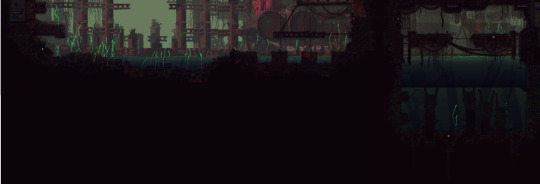




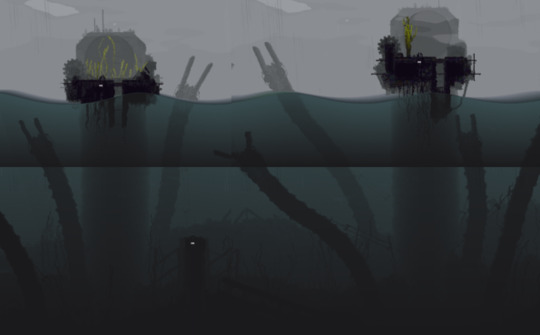
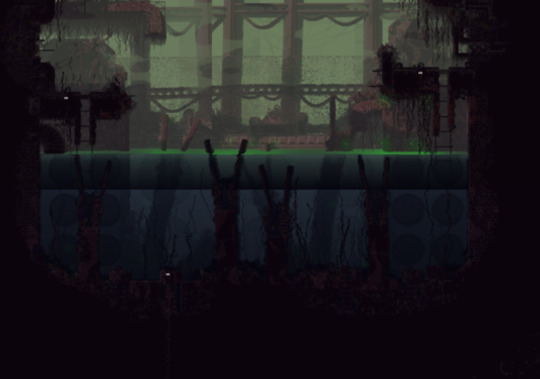
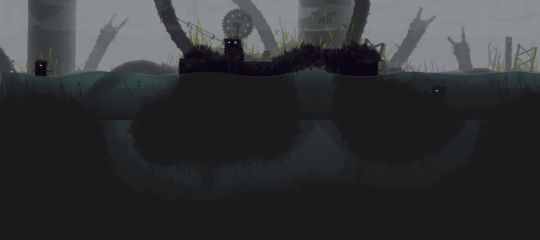
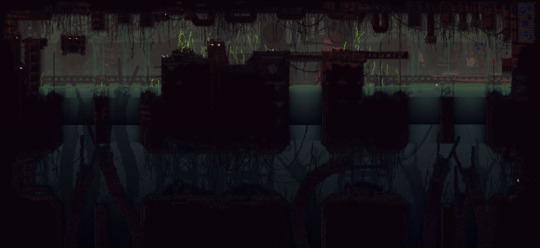
mostly putting these here to use as reference for myself, hence why the low image quality
if you want to see the map/rooms in better quality, I took these screenshots on this map website
might add more in a reblog, as this post reached image limit
99 notes
·
View notes
Note
Ah, thank you. Please let me know if anything more comes of this. It'll be interesting to see what he finds if he researches them as well.
Ok, so back in UHC's Legiana video, he posited that the various predatory flying wyverns have now filled the roles of various birds of prey in our own world. Bazel is a vulture, raths are eagles, Steve is an owl, etc.

However, he couldn't quite fit astalos into the equation. But, after a decent bit of research, I believe I have definitively figured out the group of birds astalos best represents!
It's Kites! Specifically those like the Swallow tailed and White tailed kite.


Similarly to Astalos, these birds' preferred environments are wetlands and open tropical forests. Also, like Astalos, a large portion of their diet is made up of insects surprisingly enough, which they snatch from the air or skim from foliage as they fly low. Swallow tailed kites have even been documented flying away with big chunks of wasp nests in their talons, which they eat the larvae from. In MH, we don’t really have any proper dedicated predators of vespoids. Perhaps that's what Astalos could be, in a similar way to birds like the Swallow Tailed and honey buzzards? Either way, it's cool to think about. Outside of insects, these kites are generally hunters of small prey like lizards, snakes, and frogs that they can either swallow whole or easily tear apart.
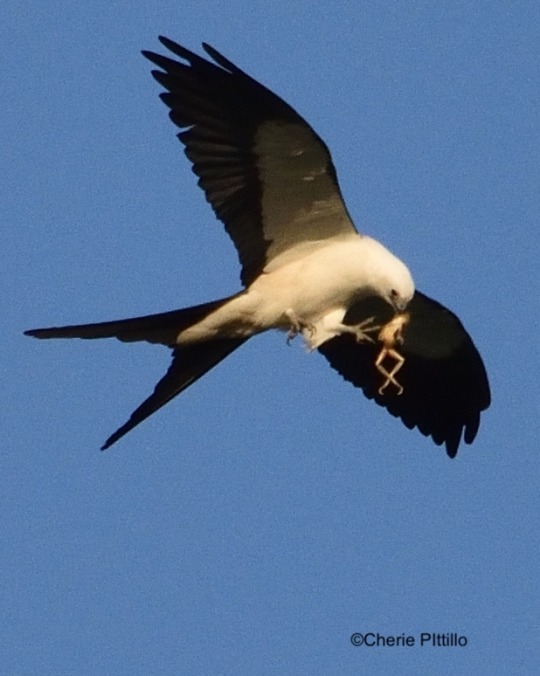
In short, very Astalos-like with its hunting of the small runner wyverns, although the pincer tail replaces the talons in this context.
Astalos isn't exactly the nightjar analog I previously thought it was, but overall, I'm satisfied with the conclusion it ultimately led me to, and even better, now I know more about these birds and real world Ecology!
Oh crap that’s actually a really good comparison.
I’m gonna run this by UHC and see what he thinks.
EDIT:
He said he’s more familiar with old world melvini kites, which are ecologically more like vultures, but that this is a very interesting thing to consider.
I let him know this came from you.
58 notes
·
View notes
Text
Reblog to give a trans woman a warm cup of soup

149K notes
·
View notes
Text
Reblog to give a trans woman a warm cup of soup

149K notes
·
View notes
Note
This actually ties into something really cool I learned about Barioth recently. Turns out, Barioth probably doesn't use its tusks like a sabertooth would at all from how it's described. The pointed tips likely aren't the actual killing weapon. It's instead the front serrated edge of the tusk that's the primary killing implement. It's used by the Barioth to slash at prey, described as being very sharp and especially able to cut through fur and fat with ease. The Barioth then simply let's the prey bleed out. It would then use its tusk serrations like a hacksaw, opening up the carcass to slurp up the fat and organs. In short, different biological pressures from that of a sabertoothed animal seem to apply to the Barioths' skull anatomy.


I am ignoring the mentions of Barioth "biting" it's prey to be fair, but only because it's physically impossible for a barioth to get its jaws around anything with how big its tusks are. I imagine it striking its prey somewhat like this, with an upward swipe of its head.

Is it treasonous to say I almost prefer barioth more this way than if it were an actual saber tooth? It's way more interesting this way, honestly. Ooh, maybe a future barioth rendition could have bleed as a statis effect since it's described as bleeding it's prey to death? That would be interesting I think!
Did a bit of a Barioth redesign, gave its tusks somewhere to have proper roots. As the resident skull expert, how would you rate my attempt?

Honestly so much better

Barioth’s skull is the only skull I’ve ever hated.
I don’t know about having the tooth roots go behind the eye though. I’m uncertain if that would work since saber tooth animals have their saber roots in front of the eyes.
49 notes
·
View notes
Note
Yeek running away from a Scavenger, ala Wile E Coyote and Roadrunner.

65 notes
·
View notes
Note
Not only that, but Lala Barinas florets are basically the equivalent of urticating tarantula hairs. I'm so happy that they finally used that feature on a spider monster.
Holy shit, the new wilds trailer. La La Barina and Rey Dau ... I might have some new favorites. This game is going to be amazing.


I will eat my pants if new spider isn’t slightly inspired by Hollow Knight. Also I literally made a post a few days ago theorizing that temnocerans might be mandibulates and the new one has a wasp face. Incredibly validating. Also Barina might have biramous limbs for its raptorial appendages?
Rey Dau seems to not be a seregios relative like I thought but a rath and espinas relative! It’s got the rath nose, mobile head horns, and mandibular spikes. It seems to have lost some wing fingers/pseudofingers but hey, Bazel.
43 notes
·
View notes
Text
Monster Hunter Wilds: 3rd Trailer | Lala Barina & Scarlet Forest Reveal
youtube
0 notes
Note
I actually don't think this is true for a specific reason. Which is astalos's use of piezoelectricity specifically. Piezoelectricity isn't created in the same way that most electric animals create their electricity (mostly by shunting positive sodium ions over and through said electrocyte muscles). Astalos instead uses piezoelectricity, which is created when a specific material is compressed and deformed in a typically rapid and repetitive fashion (i.e., its crest, wing, and tail movements) It's like the old trick of "powering a light bulb by running on a bicycle." Meaning that Astalos's electrical generation isn't in its muscles at all, it's a material in its joints and other such extremities that's being compressed BY it's muscles. In this way, Astalos actually requires a decent amount of muscle mass and endurance in order to properly generate large amounts of electricity from the exerted energy of its own movements. In this way, Astalos seems to have effectively created a way it can collect the residual energy from its own excursions to use for another purpose. The bulbous green glands on it's wings, and tail effectively act like batteries, storing electrical energy for later use. It still costs a lot. But not in the way it does for other animals.
As for the wing claws, they're more often shown being used as Tools for capturing large prey. Only once shown as being used on a rival Rathalos. With Astalos having such weak small feet, the wing claws are likely simply its primary way of restraining larger prey. All volant flying wyverns mark their territory with talon scrapes, with it's primary talons being on it's forelimbs, Astalos is probably just doing the same thing of marking it's territory. Rather than using them to capture Neopteran prey.

I think I finally figured out what Astalos is supposed to be. It's a Nightjar/Swallow. The majority of its prey are Neopterans, but instead of catching them mid-air like the birds in question, it can instead use electrical pulses from its piezoelectric organs to kill and stun them in mass as it flies through the swarm, only to land and eat them once they've fallen to the ground. This might explain why Astalos is so psycho. It's constantly spending energy on its electricity to kill large amounts of prey to sustain itself and to aquire large amounts of energy to create more piezoelectricity to aquire more prey, and so it goes on and on and on. In a way similar to animals like hummingbirds and short tailed shrews, Astalos may very well be trapped in a viscous cycle of energy acquisition and high energy expenditure. I looked closely at astalos's design as well, and it has a wing shape quite reminiscent to that of nightjars, long with pointed tips, good for sustained high speed flight. I also looked at the feet, and they're pretty much an identical copy of how nightjar feet look.


There’s a possibility that that’s what’s going on! Although there might be some issues.
Astalos’s electrogenesis might mean it can’t fly as long as other volant wyverns. Unless it has a completely novel way of generating electricity, it’s likely it’s using modified muscle tissue. Like with all electricity generating animals, these muscle cells probably gave up their ability to contract in order to maximize electricity output. This means that Astalos effectively has less “muscle” per muscle and is weaker than other creatures of similar mass.
If this is true then it might be more energy efficient to forage on the ground by using their massive claws to sift through leaf litter. And in sunbreak one of his idle animations has him do exactly that! Astalos’s third toe is noticeably bigger than his second and fourth toes, which might be an adaptation for cursoriality. It is similar to nightjars yes, but more extreme.


Thanks to @krmoaten-blog for the pics again
Male astalos also have those big knuckle duster claws that they use to brute force beat the fuck out of things, much like the males of some species of birds. These are likely an adaptation for fighting other male Astalos over mates. If male wings are more dedicated to combat than flight then they probably spend less time in the air than females (in fact a few duck species have entirely flightless males with wings dedicated exclusively for combat). This could also offer an explanation for the aggression of the Astalos we fight, which are all male. Instead of aggression caused by hunger it might instead be them using things as punching bags for practice when they fight for mates, which some of those species of ducks I mentioned do.
29 notes
·
View notes

